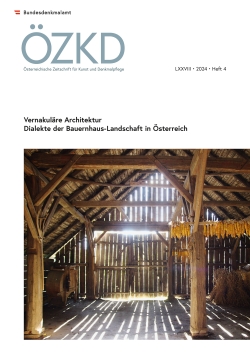
ÖZKD LXXVIII 2024 Heft 4, pp. 20-25, 2025/02/12
Vernakuläre Architektur
Dialekte der Bauernhaus-Landschaft in Österreich

In 1963, state conservator Alfred Schmeller became the first person to recognize the uniqueness of the cellar district in Heiligenbrunn. Since then, the cellar has been maintained in its present-day form by means of public funds. The ensemble, with its 106 listed historic monuments, exemplifies the continual development of cellar construction: varied building methods and cellar types form a notable ensemble of rural commercial construction from the preindustrial era that is still in use today. The buildings remain in their original positions and have not been picturesquely rearranged into a “museum village.” They document a traditional agricultural form that has experienced a resurgence since the 1960s. Due to changes in winegrowing, these buildings are losing much of their original significance. Some have fallen into decay or become quaint locales for serving drinks and selling the region’s typical Uhudler wine, although this has long been produced elsewhere.